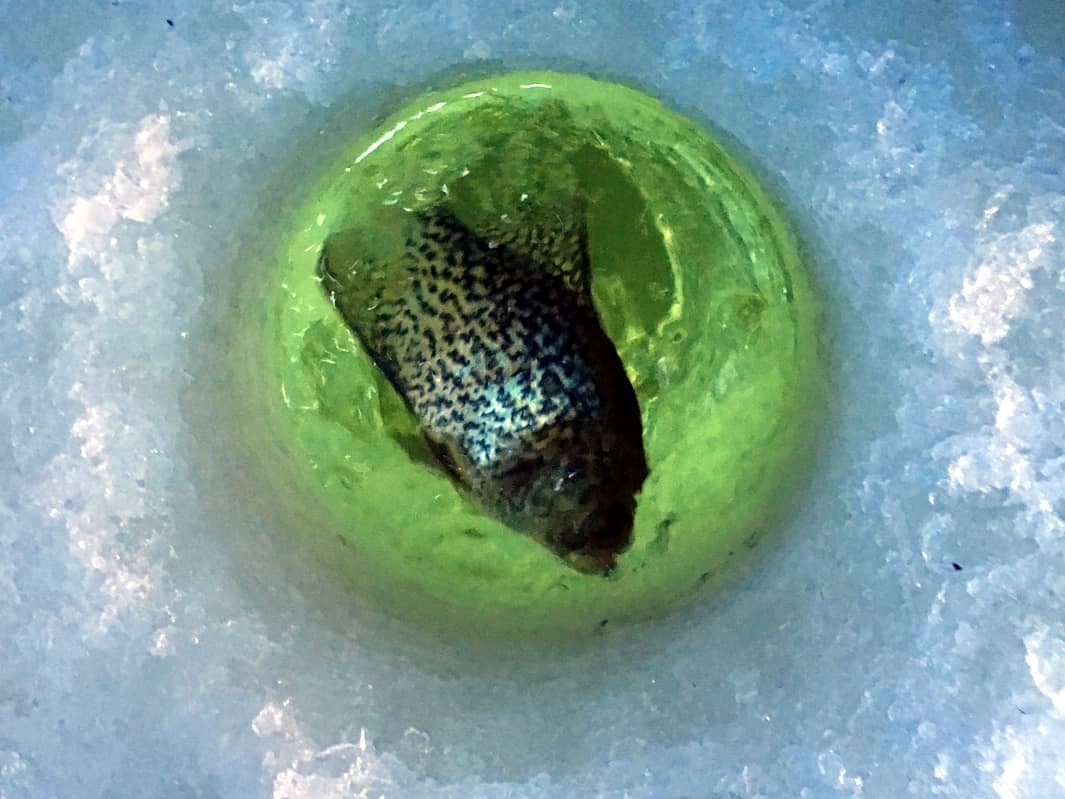
A black crappie is released down an ice hole in mid-winter. Knowing how deep fish are being caught, adjusting hook types, and limiting fish exposure to the winter elements are all slight changes that still allow successful C&R angling on the ice. Simonson Photo.
By Nick Simonson
For the last four decades, catch and release angling has been a mantra which has not only saved fisheries but also increased the quality and number of fish available in their waters, nationwide. While it’s generally a trend that more fish are kept on the ice than in the summer months and catch and release fishing methods are often easier to practice simply due to the more favorable conditions at that time, the same conservation-minded ethos can be applied to hardwater angling as well, with a bit of forethought and modification with the winter season.
Know Where You’re Fishing
Akin to those mid-summer fishing outings, where walleyes and other species push a bit deeper, it is important to recognize the depths at which fish locate in the winter, and where you may be pulling them up from, once hooked. Fish in the winter which are brought up from depths over 25 feet, in general, suffer barotrauma – or internal injury to their bodies caused by pressure changes as they rise quickly through the column – when reeled up, just like they do in summer, when they go deep to find cooler water. Make it a point to plan on keeping fish that are caught under the ice in those depths 25 feet and deeper and know that catch and release angling can be practiced on fish caught in shallower waters as they are less likely to suffer such injuries when coming up from those depths.
Look at the Hook
Many times in winter, anglers employ dead sticks and bobber rods with live bait below to catch fish while using an active lure presentation in an adjacent hole to draw them in for a look. The risk of hooking gills or gullets, and thereby causing delayed mortality if those fish are released goes up on these stationary rods which may not get the attention that an actively worked combo does. The same goes for the terminal tackle on a tip-up which is often a treble hook, and both deployments can result in deep hooking of fish. If the plan is to release undersized fish, or a limit is hit employing standard octopus-style hooks, or treble hooks on these setups, consider switching the business end over to a circle hook, which more often ends up in the corner of the fish’s mouth or its lower jaw, ensuring a less-damaging hookset and a cleaner release.
Limit Exposure
Colder temperatures in winter carry risks for fish just like the warmer conditions do in summer, and oxygen deprivation is the same in both seasons when fish are kept out of the water for long. Limit the freezing of vital body parts, such as fins and gills, caused by chilly temperatures and strong winds by letting fish go quickly back down the ice hole after being unhooked, and keeping picture time for those bigger fish to a minimum, or do it in a warm shack if possible before release. As a general rule, 20-30 seconds is the window that a fish can be out of the water before experiencing negative effects from oxygen deprivation, so keep that timeframe in mind as the shutter clicks and you ready for release.
While it isn’t often front-of-mind in winter, with ice angling having its additional challenges, catch-and-release is still practical and feasible with a few changes. Help preserve the resource, keep fish you know to be injured and release those that fall outside any required slot or after you’ve reached your possession limit to continue having fun, while preserving future opportunities on the ice.
